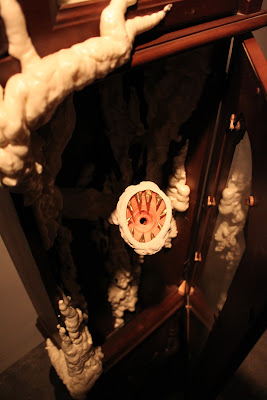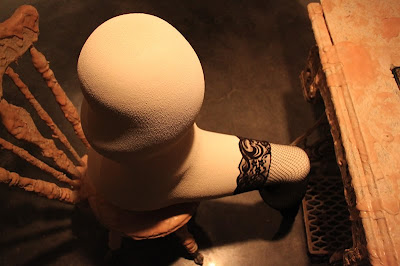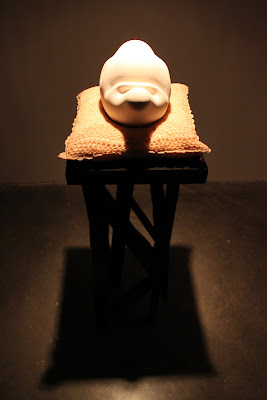
Andrew Hoeppner's BFA show, "Uncanny Reminiscence," got this semester's run of BFA shows off to a strong start. Like Aurora's show before him, the Tahoe Gallery was turned into a dimly-lit, almost cavelike space. It was a very theatrical atmosphere -- I felt like I was walking into an abstraction of a locked attic, or perhaps a shuttered bedroom.


Heppy has been creating biomorphic forms using ceramic and other materials for a while now (you can see glimpses of some progenitor figures from Heppy's Junior Portfolio Review two years ago, here), and this show seemed to mark two phases of those forms. One phase had the figures incorporated into antiques -- a fanged, goopy tapeworm emerging from a grandfather clock, or a headless torso poised at a sewing machine table, its single leg encased in fishnet, the blunt footless tip hovering over the foot pedal. Two figures in the show had mouths; the antique clutter and the implication of a voice and appetite gave these figures a cartoonish presence. I wasn't sure if they were meant to scare or amuse me -- they reminded me of cheapo monster special effects that goose your nightmares when you're a kid and then, when you see the movie again as an adult, you chuckle at them, and at your own childish susceptibility.






Heppy enjoys playing at the crossroads of the alluring and the repellant -- which is one way of saying his work seems to have a lot to do with sex. Appendages and proboscises allude to or sometimes embody human parts that are tagged as "obscene" -- if a form can at once suggest a breast, a buttock, and the swell of an ankle, well, those somatic locales tend to be charged relativistically, depending on the particular taboos of one culture or the next. Which is more enticing, the curve of a neck or the slope of a thigh? It's not impossible to imagine (and given the range of human proclivities, it's almost certain) that for someone, the locus of of sexual desire, the most transfixing and obscene part of the body, must be the earlobe.





In the Q&A I asked Heppy where he placed himself on the graph between the erotic and the pornographic, and he said he didn't identify with the word "pornographic" at all. Which surprised me, because if he saw his work as above that sort of thing, then: why fishnet? Afterward, I pursued him a little further on the subject, and he said the word "pornography" conjures a whole industry, and his work isn't about that. And then it made sense; though the idea of a "fetish" is tied to an industry (the manufacture and sale of desire through the production of latex, silicone, nylon, etc.), a fetish doesn't really need an industry to operate. At its most basic, a fetish isn't a desire manufactured but a desire reified, embedded in a texture or an image. That a texture can be produced by an industry is almost beside the point.


For me, the two most impressive figures (and the figures that seemed best to represent a second phase of Heppy's forms) were the two white, large-scale "characters" at the far end of the gallery. These figures weren't entirely free of props (both were situated in relation to rolling sheets that were stiffened by beeswax), but as well as being monumental, these forms also seemed more purified, less cartoonish. One form reclined on the bedding; the other hung on the wall above, hovering some distance from a depression on the surface of the bedding -- a spot it had perhaps recently vacated. It hovered like a lover, voyeur or ghost (and when it comes down to it, aren't ghosts perfect voyeurs -- voyeurism given the metaphoric resonance of folklore?). There was something sad about the hovering figure, and something droll about it, too. It commanded the space because of its size, its presence, its apparent defiance of gravity -- and also because of the fact that it looked less like a self-contained figure than an excerpt from a much larger figure -- it could've been a blow-up of Michelangelo's David's family jewels.



When the Q&A was over, someone requested that Heppy start up the audio that he'd arranged to emanate from the clock (which had been silenced for his artist's talk). Heppy started it up, and for several moments everyone sat quietly while the space was filled with a broken, faraway sound of chimes. The chimes didn't sound in a regular, metronomic fashion -- they were measuring a different sort of a time than is usually marked by a clock, a more liquid and subjective time. Maybe the way time passes in memory. And then someone's cell phone rang, and we all laughed, de-hypnotized, released back to our ordinary minutes.





No comments:
Post a Comment